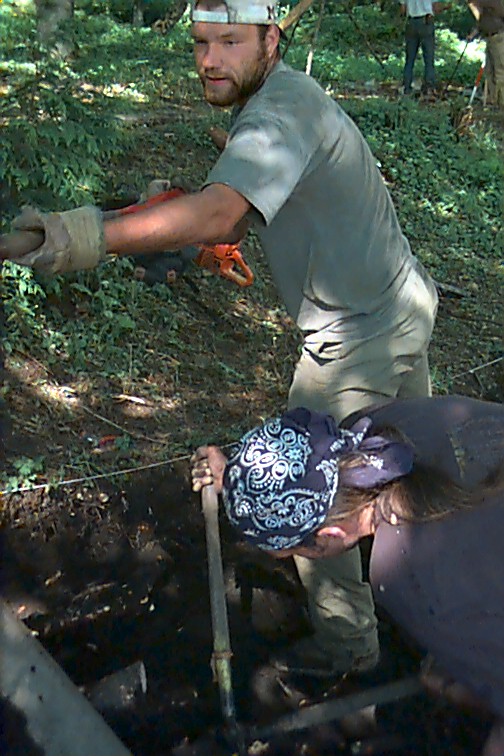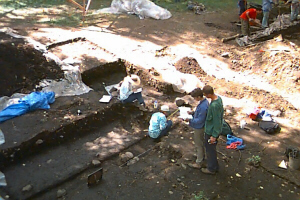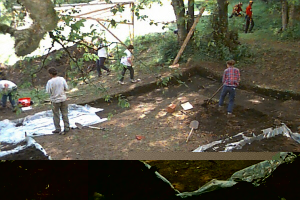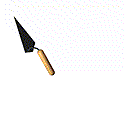'TWAS THE YEAR 1993 AT DhRl
16.....
THE SITE
In 1993, the site was now
cleared a little bit better, less trees
got in the way of our excavations.
During the spring
at DhRl 16, the grass and
stinging nettle grows back.
So, each summer begins with
a thorough clearing of the site with
machetes and grass clippers.
Hard work!!
 WHAT DO WE ALREADY KNOW?
Well, we learned a lot last
year. We now know that
the mounds were used for
burials.
We are pretty sure that
the big mounds have very
important people, like chiefs,
buried beneath them.
We also found out from our
excavation
that in front of the mounds
are flat areas that are house floors.
By observing the site, we
could see that there was many more spots
that looked like they could
be places where houses used to be.
We can tell this by
looking at the front of the mounds
and seeing how flat the
ground is.
DhRl 16 is right on the
river bank,
so the ground slopes toward
the water. But in some spots it doesn't.
This wouldn't happen naturally.
So it is possible that people
in the past flattened
(or terraced) the land so
they could build their houses on it.
This makes sense...who would
want a house that was on a slope?
Could you imagine living
in a house like that?It would
probably be pretty uncomfortable.
The people who lived here
in the past probably thought
the same thing, so they
made the ground level where their houses were.
WHAT DO WE WANT TO KNOW?
Because we found these house
floors, we want to know more
about them. How big were
they?
Are they in front
of all the mounds or just some?
Mainly we want to find out:
WHAT ARE THESE HOUSE FLOORS
DOING HERE?
WHAT DID WE DO?
Well, because we could see
so many more flat areas
in front of the mounds,
we hypothesized that they might
all be house floors, just
like the one we found
in our excavation last year.
So, to test our hypothesis,
we decided to excavate.
To do this, we dug a large
trench right through one of the flat areas.
WHAT DO WE ALREADY KNOW?
Well, we learned a lot last
year. We now know that
the mounds were used for
burials.
We are pretty sure that
the big mounds have very
important people, like chiefs,
buried beneath them.
We also found out from our
excavation
that in front of the mounds
are flat areas that are house floors.
By observing the site, we
could see that there was many more spots
that looked like they could
be places where houses used to be.
We can tell this by
looking at the front of the mounds
and seeing how flat the
ground is.
DhRl 16 is right on the
river bank,
so the ground slopes toward
the water. But in some spots it doesn't.
This wouldn't happen naturally.
So it is possible that people
in the past flattened
(or terraced) the land so
they could build their houses on it.
This makes sense...who would
want a house that was on a slope?
Could you imagine living
in a house like that?It would
probably be pretty uncomfortable.
The people who lived here
in the past probably thought
the same thing, so they
made the ground level where their houses were.
WHAT DO WE WANT TO KNOW?
Because we found these house
floors, we want to know more
about them. How big were
they?
Are they in front
of all the mounds or just some?
Mainly we want to find out:
WHAT ARE THESE HOUSE FLOORS
DOING HERE?
WHAT DID WE DO?
Well, because we could see
so many more flat areas
in front of the mounds,
we hypothesized that they might
all be house floors, just
like the one we found
in our excavation last year.
So, to test our hypothesis,
we decided to excavate.
To do this, we dug a large
trench right through one of the flat areas.
 WHAT DID WE FIND?
We found that, sure enough,
in front of some of the mounds were
more house floors!
We measured these large terraced (flat) areas and discovered that
they were very large. Dr.R.G. Matson, the archaeologist
in charge this year was
pretty sure that these house floors showed where houses had once stood
a long time ago.
The reason why these
house floors were so big was simple ...
the houses were big!
On the Northwest Coast of
B.C.,
the Sto:lo First Nations
people lived in longhouses.
In some cases, these
houses were BIG!
They were often much bigger
than the ones you and I live in now,
and they looked very different
too.
Each house was rectangular
and very long. Several families
lived in each house and
each family had its own space
inside the house. As your
family got bigger, or if more people
moved into your house,
you would just build on an addition to one end of the rectangle and PRESTO!
your house would be bigger.
Probably, the chief would
have the biggest house because
he needed a lot of room
for people to live in and for people
to come over and visit when
he had potlatches (huge parties!).
So, we learned even more
in 1993!
Not only were people buried
on this
site, underneath the mounds,
but there was also houses
that
people lived in very close
to them!
WHAT DID WE FIND?
We found that, sure enough,
in front of some of the mounds were
more house floors!
We measured these large terraced (flat) areas and discovered that
they were very large. Dr.R.G. Matson, the archaeologist
in charge this year was
pretty sure that these house floors showed where houses had once stood
a long time ago.
The reason why these
house floors were so big was simple ...
the houses were big!
On the Northwest Coast of
B.C.,
the Sto:lo First Nations
people lived in longhouses.
In some cases, these
houses were BIG!
They were often much bigger
than the ones you and I live in now,
and they looked very different
too.
Each house was rectangular
and very long. Several families
lived in each house and
each family had its own space
inside the house. As your
family got bigger, or if more people
moved into your house,
you would just build on an addition to one end of the rectangle and PRESTO!
your house would be bigger.
Probably, the chief would
have the biggest house because
he needed a lot of room
for people to live in and for people
to come over and visit when
he had potlatches (huge parties!).
So, we learned even more
in 1993!
Not only were people buried
on this
site, underneath the mounds,
but there was also houses
that
people lived in very close
to them!
 Are you curious to find
out what happened next?
Me too! Let's go to the
year 1994!
TAKE
ME THERE!
Are you curious to find
out what happened next?
Me too! Let's go to the
year 1994!
TAKE
ME THERE!






